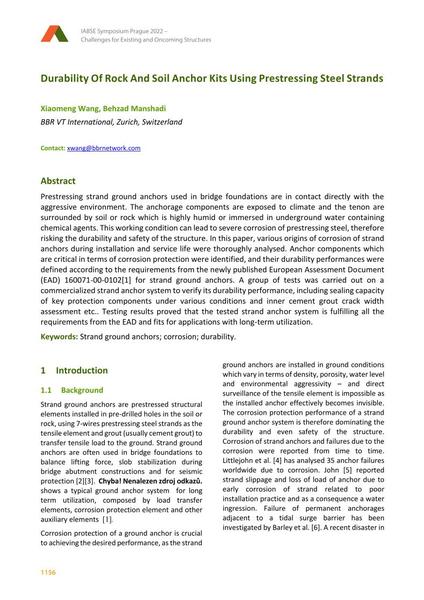Durability Of Rock And Soil Anchor Kits Using Prestressing Steel Strands

|
|
|||||||||||
Détails bibliographiques
| Auteur(s): |
Xiaomeng Wang
(BBR VT International, Zurich, Switzerland)
Behzad Manshadi (BBR VT International, Zurich, Switzerland) |
||||
|---|---|---|---|---|---|
| Médium: | papier de conférence | ||||
| Langue(s): | anglais | ||||
| Conférence: | IABSE Symposium: Challenges for Existing and Oncoming Structures, Prague, Czech Republic, 25-27 May 2022 | ||||
| Publié dans: | IABSE Symposium Prague 2022 | ||||
|
|||||
| Page(s): | 1156-1171 | ||||
| Nombre total de pages (du PDF): | 16 | ||||
| DOI: | 10.2749/prague.2022.1156 | ||||
| Abstrait: |
Prestressing strand ground anchors used in bridge foundations are in contact directly with the aggressive environment. The anchorage components are exposed to climate and the tenon are surrounded by soil or rock which is highly humid or immersed in underground water containing chemical agents. This working condition can lead to severe corrosion of prestressing steel, therefore risking the durability and safety of the structure. In this paper, various origins of corrosion of strand anchors during installation and service life were thoroughly analysed. Anchor components which are critical in terms of corrosion protection were identified, and their durability performances were defined according to the requirements from the newly published European Assessment Document (EAD) 160071-00-0102[1] for strand ground anchors. A group of tests was carried out on a commercialized strand anchor system to verify its durability performance, including sealing capacity of key protection components under various conditions and inner cement grout crack width assessment etc.. Testing results proved that the tested strand anchor system is fulfilling all the requirements from the EAD and fits for applications with long-term utilization. |
||||
| Copyright: | © 2022 International Association for Bridge and Structural Engineering (IABSE) | ||||
| License: | Cette oeuvre ne peut être utilisée sans la permission de l'auteur ou détenteur des droits. |
||||
